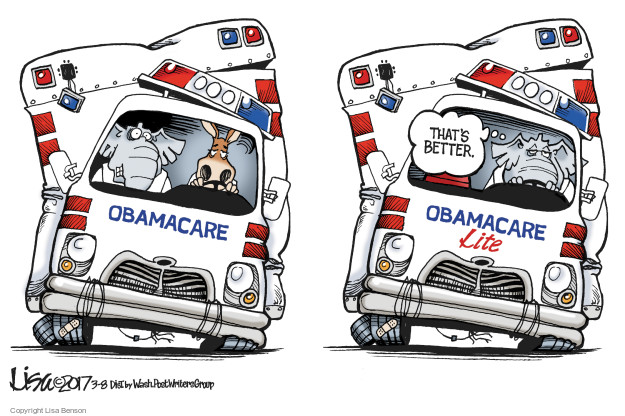
The House Republican repeal and replace proposal is a very good one. But it omits some of the major cost savings that can reduce federal spending on this entitlement and make it easier for conservatives to swallow.
A. PUT OBAMACARE ON A DIET
The reason ObamaCare costs too much with high premiums and huge deductibles is that the special interests crammed the enabling legislation with all sorts of minimum requirements for services to be included in all policies provided by the exchanges.
Unfortunately, the proposed Republican replacement leaves the requirements unchanged. This is a critical flaw. The reason ObamaCare is so costly is because of these requirements. The reason young people won’t buy it is because of the high premiums they necessitate.
These inflexible requirements drive up the cost and soak both the taxpayer and the premium payer.
ObamaCare specifies a list of services to be covered:
• Outpatient care
• Emergency care
• Hospitalization, surgery, overnight stays
• Pregnancy, maternity and newborn care
• Mental health and substance abuse
• Prescription drugs.
• Rehabilitative and habilitative services and devices
• Laboratory services
• Preventive and wellness services
• Chronic disease management
• Pediatric services including oral and vision care
• Birth control
• Breastfeeding coverage
And they all must be covered in their entirety — no exceptions, no limits.
That’s why the premiums and deductibles are so high and the program can’t succeed.
Congress should amend the law to allow catastrophic coverage only if that is what a patient wants. Currently, catastrophic coverage only plans are available only to those under 30.
It should also eliminate some of the services on this wish list and curb others:
• Make maternity care optional, particularly for men and those out of child-bearing age
• Limit wellness and preventative care
• End substance abuse coverage and limit mental health coverage
• Limit non-emergency use of ERs
B. CURBING MEDICAID
The big cost savings that can come from repealing and replacing ObamaCare will come from cuts to the Medicaid component more than to the middle-class health insurances the program offers.
More and more of federal spending under ObamaCare is going to Medicaid after Obama expanded eligibility to bring a potential of ten million new adults into the system at a cost of over $6,000 piece. Any attempt to repeal and replace ObamaCare has to focus intently on the Medicaid component. Last year, ObamaCare cost the U.S. taxpayer about $110 billion, about 60% of which was to pay for the expansion in Medicaid.
Before the ObamaCare law, eligibility for Medicaid varied widely by state, with some admitting only those below about a quarter of the poverty level. Obamacare raised the threshold to 133% of the poverty level or about $18,000 in income per person or about $24,000 for the average family. The Supreme Court gave states the right to opt in or opt out of this expansion and nineteen states chose not to participate.
The result has been that about half of the federal spending on ObamaCare has gone to Medicaid expansion. With an estimated 10 million people newly eligible for Medicaid — at an average cost of $6,000 — the financial burden is certain to swell.
In repealing ObamaCare, Congress should consider changes in Medicaid to reduce its cost. These cuts could either be enacted by the feds as part of the repeal and replace package or they could be options left on the table for states to use.
Generally, the states should divide their Medicaid populations into two categories: those whose incomes would have entitled them to coverage before the Obama expansion and those newly brought in. They should cut services and increase co-payments for the second group, people more able to pay.
• Currently co-payments under Medicaid are nominal and do not do much to deter utilization for trivial needs or to share the costs. Co-payments for drugs, for example, are generally limited to $4 and for non-emergency visits to the ER to $8. These levels befit the old Medicaid population, a group of people living in desperate poverty. But the new eligibility of families up to $24,000 in income makes if fair to charge more reasonable amounts.
• Congress (or the states) should consider limiting the services covered by Medicaid for the newly eligible population. Dental, mental health, transportation, physical therapy, speech therapy, occupational therapy are all covered. Congress and the states should consider limiting coverage to all beneficiaries or to those newly eligible.
Medicaid is a welfare program. It is not funded by people paying into the system for coverage. But it has been exempted from any efforts to curb welfare spending. Until now, an all-or-nothing approach has prevailed. Federal law prevents states from curbing or limiting the services the program provides and from charging co-payments or deductibles beyond certain specified low levels.
To make repeal and replace easier for Congress and the president, it is time to put cutting Medicaid services and spending on the table.
In summation, by adopting common sense limitations, Congress can lower the cost of ObamaCare’s exchange-offered policies.
The rhetoric of “repeal and replace” is well and good, but cutting the costs of the program itself gives Congress a great deal more flexibility in replacing it.
Dick Morris, who served as adviser to former Sen. Trent Lott (R-Miss.) and former President Clinton, is the author of 16 books, including his latest, Screwed and Here Come the Black Helicopters.


 Contact The Editor
Contact The Editor
 Articles By This Author
Articles By This Author